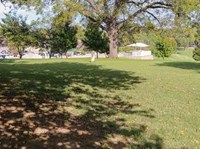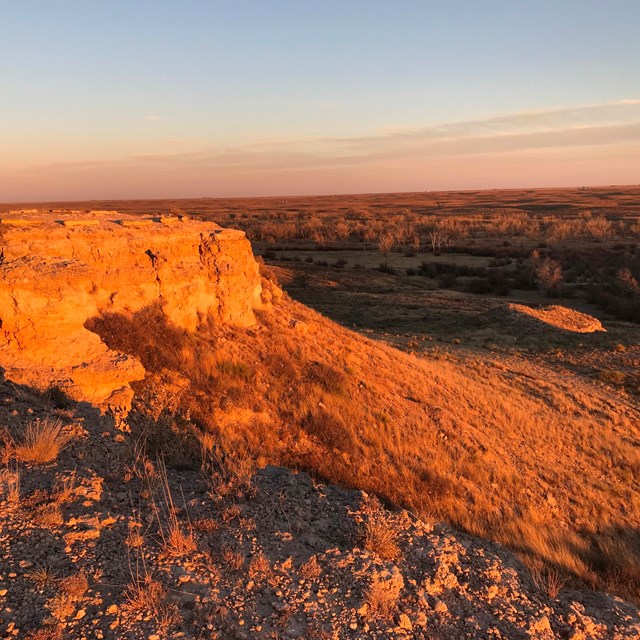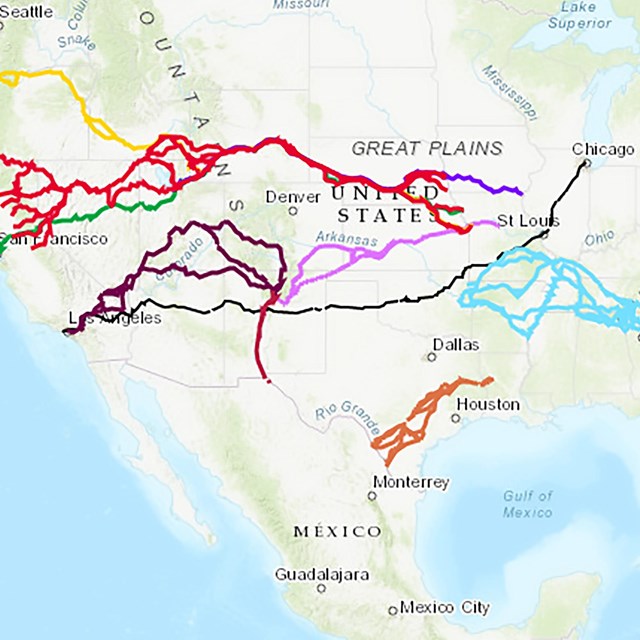Last updated: January 20, 2021
Thing to Do
View Santa Fe Trail Ruts

Photo/NPS
Trail Ruts
Imagine Prairie Schooners rumbling over the landscape, 10 feet tall and 23 feet long (with yoke). Imagine further that today you can still see evidence of those 44-50-inch diameter wooden wheels in the terrain from Missouri to New Mexico!
Their traces are often referred to as wagon ruts and they can appear a variety of ways depending on the type of soil and the continued effects of water erosion. In some places, the ruts might look like a very obvious ditch, and in others they might be a wider, shallower, drainage.
One of the best ways to experience the Santa Fe Trail is by taking a step back in time while visiting a trail rut. Luckily, there are still places where you can have that experience today. Take a look at the the list below and plan your visit to the mid-1800s today!
Follow the ruts:
Minor Park
Emigrants heading west from Independence encountered their first river crossing at Minor Park, a preview of the many water crossings to be negotiated on their long journey west. Here, wagon trains crossed the Blue River by fording, since the first bridge across the river wasn't constructed until 1859. Numerous emigrants wrote about or mentioned the crossing in their diaries.
New Santa Fe Cemetery Trail Ruts
The Santa Fe, Oregon, and California national historic trails (NHTs) passed through "New Santa Fe" in the Kansas City, Missouri area. Visit to see rare urban trail ruts and what’s left of a town created by trail traffic.
Santa Fe Park
Santa Fe Park preserves approximately one-quarter mile of Oregon, California, and Santa Fe trail ruts in the heart of the city of Independence, Missouri. These ruts align with trail ruts found a half mile north on the Bingham-Waggoner estate, a 19.5 acre museum and park, that is open to the public.
Wieduwilt Swales (85th and Manchester)
Wieduwilt Swales are the grassed-over evidence of three historic trails that passed through the area, the Santa Fe, California, and Oregon. Thousands of wagons, carts, livestock, and people traveled on these trails, which created ruts and left deep depressions in the earth. After the traffic stopped, vegetation slowly reclaimed the muddy and barren ground of the trails, creating the swales that are still visible today.
Ralph's Ruts
At Ralph’s Ruts, you can see physical marks on the land from the thousands of wagon trains that carried goods on the Santa Fe Trail. They are some of the best preserved in the nation. The preservation of the site is due to one family’s decision to protect the historical importance of the swales and their willingness to let the public experience the swales on their land.
Black Jack Ruts
These pronounced ruts bear witness to the passage of thousands of Santa Fe Trail travelers. They also were of strategic value during the Battle of Black Jack (June 2, 1856), because participants hid from enemy fire by hiding in the ruts.
Prairie Village Santa Fe Trail Park
Prairie Village Ruts marks the location of the Oregon, California, and Santa Fe Trails in the form of rounded depressions in the ground called swales. These swales were once part of a well-defined path, most equivalent to a modern day dirt road, that was created as thousands of oxen, cattle, and wagons traveled across the land. They eroded and compacted the ground, which created ruts. Over time, the ruts were weathered into the more gently sloping swales visible today.
For more location information: Places to Go on the Santa Fe Trail
Because of the varied nature, rural character, and mixed public and private ownership of the many sites making up the Santa Fe National Historic Trail, it is best that you inquire locally about accessibility at each location.
Places to View Trail Ruts
- Sites: California National Historic Trail, Oregon National Historic Trail, Santa Fe National Historic Trail

Emigrants heading west from Independence encountered their first river crossing at Minor Park, a preview of the many water crossings to be negotiated on their long journey west. Here, wagon trains crossed the Blue River by fording, since the first bridge across the river wasn't constructed until 1859. Numerous emigrants wrote about or mentioned the crossing in their diaries.
- Sites: California National Historic Trail, Oregon National Historic Trail, Santa Fe National Historic Trail
- Sites: California National Historic Trail, Oregon National Historic Trail, Santa Fe National Historic Trail
- Sites: California National Historic Trail, Oregon National Historic Trail, Santa Fe National Historic Trail

Prairie Village Ruts marks the location of the Oregon, California, and Santa Fe Trails in the form of rounded depressions in the ground called swales. These swales were once part of a well-defined path, most equivalent to a modern day dirt road, that was created as thousands of oxen, cattle, and wagons traveled across the land. They eroded and compacted the ground, which created ruts. Over time, the ruts were weathered into the more gently sloping swales visible today.
- Santa Fe National Historic Trail
Black Jack Ruts
- Santa Fe National Historic Trail
Ralph's Ruts

At Ralph’s Ruts, you can see physical marks on the land from the thousands of wagon trains that carried goods on the Santa Fe Trail. They are some of the best preserved in the nation. The preservation of the site is due to one family’s decision to protect the historical importance of the swales and their willingness to let the public experience the swales on their land.
- Sites: California National Historic Trail, Oregon National Historic Trail, Santa Fe National Historic Trail

Wieduwilt Swales are the grassed-over evidence of three historic trails that passed through the area, the Santa Fe, California, and Oregon. Thousands of wagons, carts, livestock, and people traveled on these trails, which created ruts and left deep depressions in the earth. After the traffic stopped, vegetation slowly reclaimed the muddy and barren ground of the trails, creating the swales that are still visible today.





